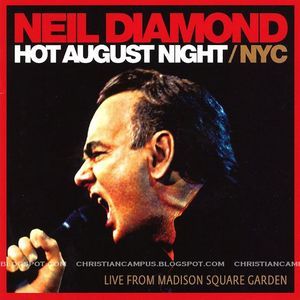
“He looked up, the music stopped — and a man held a sign: ‘I Am the Boy From Brooklyn.’ Neil Diamond froze, tears in his eyes, as a childhood ghost returned to the stage…”
The night was supposed to be another chapter in Neil Diamond’s long farewell tour — a bittersweet reminder of what Parkinson’s had taken and what music had preserved. Seated in his wheelchair, draped in the glow of stadium lights, the 84-year-old legend began strumming the opening chords of “Brooklyn Roads.” For many fans, it was a nostalgic anthem about childhood streets, cramped apartments, and the fragile hope of young dreams. But for Neil, it was more than a song. It was a memory.
And then, in the middle of the first verse, the memory suddenly came alive.
From the front row, a man in his seventies lifted a hand-painted sign, shaky but clear:
“I AM THAT BOY FROM BROOKLYN.”

The audience gasped. Neil stopped mid-lyric. His eyes, once fixed on the fretboard, slowly traveled to the sign. He squinted, blinked twice, and then — with a visible tremor in his hands — set down his guitar. The silence that followed was thunderous.
The man holding the sign didn’t flinch. His silver hair caught the spotlight. His voice cracked as he shouted, “Neil… it’s me. Tommy. From Sterling Place.”
For a second, it felt as if the entire arena disappeared, leaving only two boys from Brooklyn — one who became a global superstar, the other who carried the quiet memory of their childhood streets.
Neil’s lips trembled into a smile. He whispered into the mic, almost afraid the moment would vanish if he spoke too loudly:
“My God… you’re here.”
The story spilled out in fragments later. Decades ago, before fame, before “Sweet Caroline,” Neil Diamond had lived on Sterling Place, a working-class block in Brooklyn. Across the street was Tommy, the boy who would sit with Neil on stoops, swap baseball cards, and talk about dreams too big for their neighborhood. It was Tommy’s laughter, his wide-eyed wonder, and his stubborn belief in possibility that inspired Neil to craft “Brooklyn Roads.” But like so many friendships of youth, life pulled them apart.
Until tonight.
Tommy’s father had moved the family away in the mid-1950s. They never reconnected. Yet when “Brooklyn Roads” became a staple on Diamond’s records, Tommy’s family recognized details too intimate to ignore — the smell of the stairwell, the sounds of radios drifting through paper-thin walls, even the old wallpaper pattern. They knew Neil was singing about him. But Tommy never had the chance to tell Neil in person. Not until this night, more than sixty years later.
Back onstage, Neil waved for security to bring Tommy forward. The crowd erupted in disbelief as the two men, both weathered by time, faced each other under the harsh glow of the spotlight. Tommy reached for Neil’s hand. Neil, his voice breaking, said only one thing:
“You kept me alive in that song.”
Barbra Streisand once said Neil Diamond’s music carried “the smell of home.” Tonight, that home walked back into his life. Fans wept openly as Neil asked Tommy to sit beside him on stage. He restarted “Brooklyn Roads,” this time pausing at the line: “I fought every step of the way…” He leaned toward Tommy and whispered into the microphone:
“This one belongs to us now.”
And then something remarkable happened. Twenty thousand people sang not as strangers but as witnesses to a reunion that felt holy. The verses became a prayer, the chorus a reconciliation. Tommy wiped his eyes. Neil strummed on, shaky but defiant, as if reclaiming every lost year in each note.
By the time the final chord faded, Neil’s cheeks were wet, his voice gone hoarse. He looked at Tommy, then back to the crowd, and said:
“Don’t let anyone tell you songs don’t come from real places. This one came from Brooklyn… and tonight Brooklyn came back to me.”
The arena erupted into a standing ovation that lasted minutes. Some fans said they had never witnessed anything more raw on a concert stage. Others called it destiny — that fate had carried both men through eight decades just to collide again in the language of music.
After the show, social media exploded. “We just saw history,” one fan posted. “Neil Diamond found his ghost, and they sang together.” Another wrote, “That wasn’t a concert. That was a resurrection.”
For Neil Diamond, battling Parkinson’s yet refusing to surrender his music, the reunion with Tommy was more than nostalgia. It was proof that even as memory fades and time weakens the body, the bonds of childhood — and the songs they inspire — never truly die.
As the lights dimmed and fans filed out, one image lingered: Neil Diamond, frail but unbroken, holding the hand of the boy who once shared his Brooklyn dream. Two lives, two roads, finally meeting again in harmony.
And in that moment, the song “Brooklyn Roads” wasn’t just Neil Diamond’s anymore. It belonged to both of them — and to everyone who’s ever longed for a piece of home that time tried to steal.





